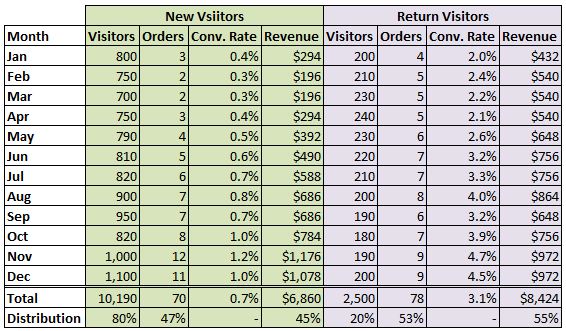
KPIs and Tactics to Grow Returning and Loyal Site Visitors
Customer satisfaction influences how consumers will purchase from your store again. Their satisfaction could influence their future behavior to purchase online, offline, recommend website, return to website, commit to a brand, and general retail satisfaction.
In this article, I would like to focus on tactics to increase KPIs relating to return visitors or loyalty customers. The common metrics in web analytics tools to measure loyal visitors are return visitors, loyalty metrics like frequency and recency, or number of advocates.
It is very common that conversions for eCommerce are likely to be higher for returning visitors to the site. That is because consumers are researching online and may visit the site again later to finalize their shopping.
According to Foresee’s research, “Compared to shoppers who are dissatisfied with an online experience, shoppers who are highly satisfied with a retail website are 65% more likely to purchase online and 44% more likely to return to the website than those who are dissatisfied.”
That is a very convincing statement to support why you should focus on converting your customers from new to return and make them loyal to your service and brand. Obviously, your customer has to be satisfied to be loyal, but let’s focus on the web analytics and the tactics and strategies to improve the KPIs.
Let’s layout some KPIs, and discuss some example tactics and strategies to improve it. Return visitors, frequency, recency, conversion rate, revenue distribution, new and return visitors distribution.
These are common measures you can acquire from the web analytics tool out there in 2010. It is typically based on site visitors who were cookied or not. Caveat is that if users delete their cookie or switch their browser, they won’t be recognized as return visitors; instead they’ll be tracked as new visitors.
What to look for in returning visitors are the number and growth in returning site visitors, conversion rate, and revenue contribution and distribution. You don’t want to take action before knowing where you stand.
The number of returning visitors doesn’t mean anything, but if you add some context, then it can tell you a lot. Here is an example of what you can start off with:

I just randomly made this up, so don’t worry so much about the actual values. The idea is understand your current numbers, and where you stand. You might want to start from here and understand the growth and distribution of new and return visitors, and their revenue attribution.
Ask following questions on how well your site is doing on:
- New and return visitors. Are they both growing or not? In above example, your overall traffic is growing, but return visitors are not growing. Sad…
- Is your returning visitor’s distribution relative to overall visitors low or high? 20% of the site traffic is return visitors, and about 80% new visitors.
- How much is the revenue distribution between new and returning visitors? 20% of your site visitors are returning traffic and they are contributing 55% of the revenue!!
- Conversion rate for return and new visitors. What is the difference? Typically, return visitors are much higher than new visitors.
So from this scenario some the actions you can plan and take are:
- Grow that number of return visitors. You need to look at recency metrics and continue to improve that number so return visitors are coming to your site in shorter time span. Market to them, and continue to offer fresh ideas, content, products, price, features, and services.
- Improve conversion rate for new visitors as much as you can. If you set up your site so users can opt-in to receive future message from you, you can remarket to the converted customers.
- Improve conversion rate for both new and returning visitors, and do it through testing. Always test, test, and test. Testing in this case is web site optimization through A/B, multivariate testing, etc.
- Don’t worry so much about new and returning visitor’s revenue distribution. Think about the growth of retuning visitors, because that means your strategy to bring in more loyal customers is working.
Few tactics I’ve mentioned here to move that KPI’s are:
- Fresh content, services, products, ideas, right price, features, etc. You have to have something to spark the interests of your consumers so they come back.
- Re-marketing. Re-market to current customers because you know they are likely to buy from you again. Re-marketing could be done through newsletters, emails, calling, sending out coupons to current customers, DM, etc.
Thank you so much for taking the time to read my content. If you've liked what I've had to say please subscribe!
ZoomMetrix Newsletter
Join the newsletter to receive the latest updates in your inbox.